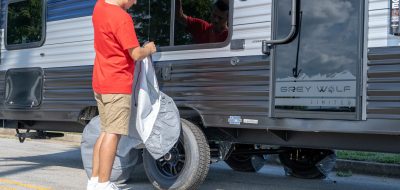 We are completing our visit to the Kentucky Bourbon Trail, with stops at Woodford Reserve, Four Roses, Wild Turkey and Buffalo Trace. (Buffalo Trace, owned by Sazerac of New Orleans, is not on the official trail.)
We are completing our visit to the Kentucky Bourbon Trail, with stops at Woodford Reserve, Four Roses, Wild Turkey and Buffalo Trace. (Buffalo Trace, owned by Sazerac of New Orleans, is not on the official trail.)
Woodford Reserve
Our journey continues near historic Versailles at popular Woodford Reserve, the smallest distillery in Kentucky and also the oldest, begun in 1797. Driving there you follow county lanes for miles, through a world of green pastures, brown fences and grazing equines, the horse farms for which Kentucky is also famous (Woodford owns one).
The distillery is as elegant as the landscape surrounding it and combines old with new: fine 19th century stone buildings that are now on the National Register of Historic Places, and an equally spacious veranda.
The distillery’s history is told on placards; an eight-minute video explains further; and in specialized “Corn to Cork” and “National Landmark” tours that are offered. Three years before the turn of the 19th century, Elijah Pepper moved here from Virginia and built a small distillery in Versailles. Fifteen years later he moved the operation here, to a more reliable water supply. He died in 1831 and was succeeded by his son, Oscar, whose distiller, James Crow, “introduced scientific procedures” to whiskey making.
A placard states that Kentucky Senator Henry Clay annually ordered a barrel of “Crow’s finest to Washington, to lubricate the wheels of government.” And statesman/ orator Daniel Webster “was never without a demijohn of ‘Crow.”‘
In 1878 the distillery was sold to whiskey brokers Leopold Labrot and James Graham, who changed the name to Labrot and Graham. Shut down during Prohibition, it was bought in 1940 by Brown-Forman, closed less than three decades later and was sold for farm land.
But in an odd twist, the company bought it back in 1994, reopening two years later after a $7 million renovation. In 2003 the name was changed to Woodford Reserve “in honor of its leading brand.” Woodford Reserve is the “Official Bourbon of the Kentucky Derby,” and since 1999 has released a special bottling for each running ofthe Derby.
Tours lead past the cypress wood fermenting tanks where the mash is bubbling (and visitors can try a taste of the sour glop), and into the distilling room, where copper-pot stills triple distill the mash. The tour ends at the stone aging warehouse, the country’s last to survive. Stone walls allow the building to heat and cool slowly as the seasons change, enabling the bourbon to mature “smoothly and consistently.” Barrels are aged here at least six years.
The visitor center includes a gift shop where souvenir bottles of Woodford Reserve, personalized bottles, and a selection of commemorative bottles are available, as are other related items. Visit woodfordreserve.com for tour information. Information on the Kentucky Bourbon Trail.
Four Roses
Our journey continues in Lawrenceburg at Four Roses, one of the oldest, if not the smallest or largest of Kentucky’s distilleries. The elegant Spanish Mission-style architecture of its mustard-colored buildings date from 1910 and is listed on the National Register of Historic Places.
Tour guide Terry Noel points out that the Four Roses distillery and brand are old by American standards. The distillery dates back nearly 200 years and the brand more than a century. The history is convoluted, and if the fine bourbon produced here doesn’t have the household-word familiarity of other brands, it’s because until fairly recently it wasn’t sold in the United States. The original distillery, known as Old Joe, was founded on nearby Gilbert’s Creek in 1818. It changed hands many times over the years, and in 1904 was purchased by the four sons of J.T.S. Brown (whose half brother, George Brown, founded Brown-Forman, owner today of numerous brands, including Woodford Reserve). The brothers built the elegant structures of today.
How the Four Roses “brand” came into existence is not really known, but there are several theories. According to one it was begun in Atlanta in 1888 by Paul Jones, Jr.; another version says Jones acquired it from Atlanta whiskey-maker Rufus Rose, who with his brother, Origen, and two sons-the “four Roses”-had founded the firm. The third possibility, nicely poetic but unlikely, involves a southern belle, a marriage proposal and a corsage of four red roses.
In any case the Paul Jones Company moved to Kentucky, and in 1943 was bought by Seagram’s, primarily for the name “Four Roses,” which at the time was the best-selling bourbon in the country. A decade later Seagram’s began restricting sales of Four Roses “straight bourbon” to overseas markets, where it also sold well, while for U.S. consumers the only Four Roses brand available was lower grade “American,” a blended whiskey.
That changed after Japanese beer maker Kirin bought the company in 2002 “and began repairing the tarnished image,” said Noel. Four Roses was brought back as a “straight bourbon,” the 80-proof yellow label. Four Roses “single barrel” came next followed by Four Roses “small batch,” he said. Now, a series of limited edition single-barrel bourbons-no “mingling”-is also offered. He also explained that Four Roses is the only distillery to combine five different yeast strains with two separate “mashbills” (grain recipes) to produce ten distinct bourbons.
Only the distilling is done here, overseen by Jim Rutledge, master distiller for the past 44 years, he continued. The agingin single-story warehouses, unlike other distilleries-and the bottling take place at Cox’s Creek just north of Bardstown 45 miles away. Noel added that in 2009 Four Roses, “operating 24/7 with 47 employees,” produced 43,000 barrels of bourbon. At the end of the tour a bourbon “tasting” is offered. Visit fourrosesbourbon.com for more information.
Wild Turkey
Our last stop on the Bourbon Trail is at Wild Turkey, a 900-acre spread outside Lawrenceburg, where a sign reads: “Bourbon Lovers, Welcome to Paradise.” A whiskey barrel “turkey” waits at the visitor center. Inside, a six-minute video provides a virtual tour of the distillery, but far better is the actual tour led by informative guide Alan Tenniswood.
He explains that a distillery was founded nearby along the Kentucky River in 1869, but was moved to this high-up location where views of the surrounding country are dramatic-when the railroad arrived nine years later. Before the railroad, the whiskey was transported by flatboat to the Ohio, the Mississippi and on south to New Orleans, where “nearly all the product was sold,” he said.
But the “product” wasn’t called Wild Turkey until1940, given the name
“inadvertently” by Austin Nichols Distilling Company executive, sportsman Thomas McCarthy, who gathered with friends each year for a turkey hunt, said Tenniswood. One year he brought along a bottle of whiskey from his warehouse, and the next year his friends insisted he bring more of that “wild turkey bourbon.” The name stuck.
The bourbon-making process doesn’t vary a lot from distillery to distillery, said Tenniswood, but Wild Turkey claims a few distinctions, among them the longest reigning master distiller in the industry, Jimmy Russell, 76, who’s been here since 1954 (originally in maintenance, he acquired his current title a dozen years later). Now his son, Eddie Russell, no newcomer at 30 years on the job, is associate distiller. The ability to do the work, which requires “subtle taste buds,” is “genetic,” said Tenniswood.
Wild Turkey (owned since 2009 by Cam pari of Milan, Italy) employs 70 workers; produces four bourbons and two rye whiskeys; requires 4000 bushels of corn a day, five days a week during the September-June production season, according to Tenniswood. Four silos hold a week’s worth. Seventeen 15,000-gallon tanks and nine 30,000-gallon tanks ferment the mash. A 48-foot high, fivefoot diameter copper still performs the alchemy of distillation. Aging-six to 12-plus years-is done at 28 warehouses, bottling at a plant in Fort Smith, Arkansas.
Also from Tenniswood we learned the origin of the term “proof” referring to alcoholic strength. It was determined originally by mixing equal amounts of liquor and gunpowder and applying a flame. If the mixture failed to burn, the spirit was too weak. If it burned too brightly, the spirit was too strong. But if it burned evenly with a blue flame it “was said to have been ‘100 percent proved right’ or ‘100 percent proof,”‘ he said.
The tour ends at antique Warehouse A, where 15,000 barrels of bourbon are aging, leaking ever so slightly and filling the air with an intoxicating fragrance called “angel’s share.”
Smiling, Tenniswood said he “likes to think it’s the part angels can appreciate as it drifts toward heaven.”
Bourbon tasting is available at the visitor center. Try the Wild Turkey American Honey, a bourbon-based liqueur with a “nose” of citrus and “palate” of honey and caramel (a nectar for the gods if not the angels!).
For more information on Wild Turkey visit wildturkeybourbon.com. And for more information on the Kentucky Bourbon Trail, visit kybourbontrail.com.




